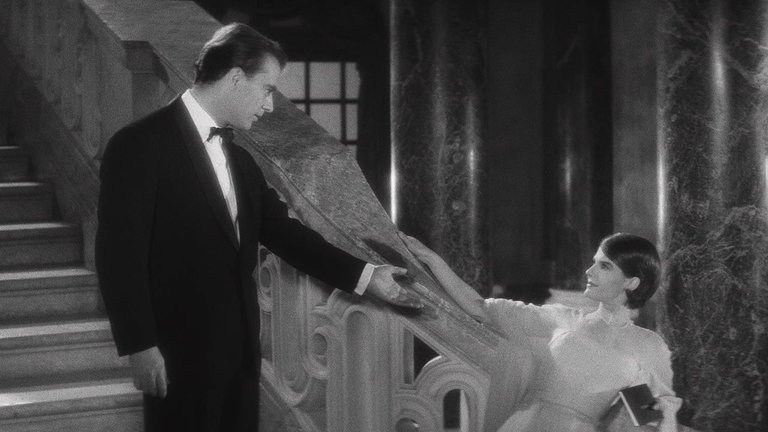Film Review: Last Year at Marienbad (L'Année dernière à Marienbad, 1961)

The distinction between art cinema and commercial cinema often blurs, yet in certain instances, it becomes strikingly clear. One such case is Last Year at Marienbad, a 1961 psychological drama directed by Alain Resnais. This film has garnered significant acclaim from critics, winning the prestigious Golden Lion at the Venice Film Festival. However, it remains a polarising experience for general audiences, many of whom may find its narrative too perplexing or its pacing excessively slow to appreciate fully.
The screenplay for Last Year at Marienbad was written by Alain Robbe-Grillet, a prominent figure in the Nouveau Roman literary movement. This movement advocated for a departure from traditional narrative structures, encouraging writers to eschew conventional plots and character development. Robbe-Grillet's principles resonate closely with those of the French New Wave cinema, making him a kindred spirit to director Resnais. Following the film's release, Robbe-Grillet adapted the script into a "ciné-roman," a novel illustrated with stills from the film, further blurring the lines between literature and cinema.
Set within an opulent Baroque palace that has been transformed into a luxury hotel, Last Year in Marienbad introduces us to a gathering of high society. The story revolves around an unnamed protagonist, referred to as "X" in Robbe-Grillet's novel and portrayed by Giorgio Albertazzi. He encounters a captivating woman, known as "A" (played by Delphine Seyrig), and insists that they shared a passionate affair the previous year and had planned to elope. However, A does not remember this encounter and is accompanied by a sinister man referred to as "M" (Sacha Pitoëff), who may be her husband or lover. This setup creates an atmosphere of tension and uncertainty, as X's insistence clashes with A's lack of recollection.
In many celebrated art films, style often takes precedence over substance, and Last Year at Marienbad is no exception. Its unconventional narrative structure appears revolutionary for early 1960s cinephiles, as it plays with the reconstruction of memories that may exist only in fantasy. By rejecting traditional notions of plot and character development—where characters remain enigmatic figures throughout—Resnais encourages viewers to engage actively with the film's themes and fill in the gaps left by its ambiguity. However, this approach can render the film utterly bewildering for some audiences. Those who persevere may find themselves compelled to construct various interpretations regarding the protagonists' identities, the film's setting, and the nature of their relationship.
Visually, Last Year at Marienbad is nothing short of stunning. The brilliant black-and-white cinematography by Sacha Vierny, combined with the widescreen format, creates an almost otherworldly atmosphere that evokes both beauty and unease. The luxurious yet oppressive environment suggests a space that could be either paradise or purgatory. This sense of otherworldliness is further enhanced by exquisite costumes designed by Chanel, which contribute to the film's dreamlike quality.
Despite its visual splendour, the film's soundtrack leaves much to be desired. Francis Seyrig’s organ music often feels intrusive rather than atmospheric; it adds an unnecessary layer of Gothic melodrama that detracts from the overall experience. Rather than enhancing the film’s haunting qualities, the score can come across as pretentious and jarring.
Another significant issue lies in the film’s pacing. Resnais frequently employs repetition of lines among characters, which can lead to a sense of monotony that diminishes viewer engagement. As scenes unfold with little variation or development, audiences may find their interest waning as they struggle to remain invested in what happens next.
Ultimately, Last Year at Marienbad serves as a cinematic Rorschach test that divides viewers sharply into two camps: those who revere it as a masterpiece of art cinema and those who dismiss it as an exercise in pretentiousness. For some critics and cinephiles, its enigmatic nature is precisely what makes it compelling—a challenging work that invites deep analysis and interpretation. Yet for others, its lack of clear narrative direction renders it tedious and unfulfilling.
Notably, despite its polarising reception, Last Year at Marienbad has undeniably influenced several prominent filmmakers, including Stanley Kubrick. Its stylistic innovations can be seen echoed in works such as The Shining. For those curious about Resnais' vision but hesitant to commit to an hour-and-a-half viewing experience, one might explore Blur’s 1994 music video “To the End,” which pays homage to this iconic film.
RATING: 4/10 (+)
Blog in Croatian https://draxblog.com
Blog in English https://draxreview.wordpress.com/
InLeo blog https://inleo.io/@drax.leo
Hiveonboard: https://hiveonboard.com?ref=drax
Rising Star game: https://www.risingstargame.com?referrer=drax
1Inch: https://1inch.exchange/#/r/0x83823d8CCB74F828148258BB4457642124b1328e
BTC donations: 1EWxiMiP6iiG9rger3NuUSd6HByaxQWafG
ETH donations: 0xB305F144323b99e6f8b1d66f5D7DE78B498C32A7
BCH donations: qpvxw0jax79lhmvlgcldkzpqanf03r9cjv8y6gtmk9
Posted Using InLeo Alpha